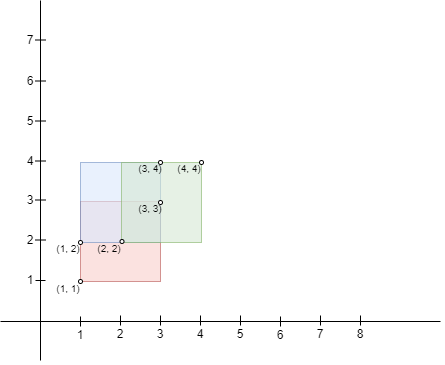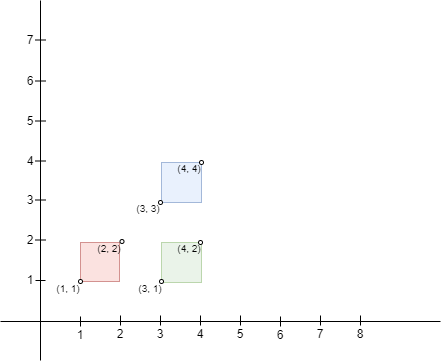3047. Find the Largest Area of Square Inside Two Rectangles
Description
There exist n rectangles in a 2D plane. You are given two 0-indexed 2D integer arrays bottomLeft and topRight, both of size n x 2, where bottomLeft[i] and topRight[i] represent the bottom-left and top-right coordinates of the ith rectangle respectively.
You can select a region formed from the intersection of two of the given rectangles. You need to find the largest area of a square that can fit inside this region if you select the region optimally.
Return the largest possible area of a square, or 0 if there do not exist any intersecting regions between the rectangles.
Example 1:
Input: bottomLeft = [[1,1],[2,2],[3,1]], topRight = [[3,3],[4,4],[6,6]] Output: 1 Explanation: A square with side length 1 can fit inside either the intersecting region of rectangle 0 and rectangle 1, or the intersecting region of rectangle 1 and rectangle 2. Hence the largest area is side * side which is 1 * 1 == 1. It can be shown that a square with a greater side length can not fit inside any intersecting region.
Example 2:
Input: bottomLeft = [[1,1],[2,2],[1,2]], topRight = [[3,3],[4,4],[3,4]] Output: 1 Explanation: A square with side length 1 can fit inside either the intersecting region of rectangle 0 and rectangle 1, the intersecting region of rectangle 1 and rectangle 2, or the intersection region of all 3 rectangles. Hence the largest area is side * side which is 1 * 1 == 1. It can be shown that a square with a greater side length can not fit inside any intersecting region. Note that the region can be formed by the intersection of more than 2 rectangles.
Example 3:
Input: bottomLeft = [[1,1],[3,3],[3,1]], topRight = [[2,2],[4,4],[4,2]] Output: 0 Explanation: No pair of rectangles intersect, hence, we return 0.
Constraints:
n == bottomLeft.length == topRight.length2 <= n <= 103bottomLeft[i].length == topRight[i].length == 21 <= bottomLeft[i][0], bottomLeft[i][1] <= 1071 <= topRight[i][0], topRight[i][1] <= 107bottomLeft[i][0] < topRight[i][0]bottomLeft[i][1] < topRight[i][1]
Solutions
Solution 1: Enumeration
We can enumerate two rectangles, where the coordinates of the bottom left and top right corners of rectangle 1 are $(x_1, y_1)$ and $(x_2, y_2)$ respectively, and the coordinates of the bottom left and top right corners of rectangle 2 are $(x_3, y_3)$ and $(x_4, y_4)$ respectively.
If rectangle 1 and rectangle 2 intersect, then the coordinates of the intersection are:
- The x-coordinate of the bottom left corner is the maximum of the x-coordinates of the bottom left corners of the two rectangles, i.e., $\max(x_1, x_3)$;
- The y-coordinate of the bottom left corner is the maximum of the y-coordinates of the bottom left corners of the two rectangles, i.e., $\max(y_1, y_3)$;
- The x-coordinate of the top right corner is the minimum of the x-coordinates of the top right corners of the two rectangles, i.e., $\min(x_2, x_4)$;
- The y-coordinate of the top right corner is the minimum of the y-coordinates of the top right corners of the two rectangles, i.e., $\min(y_2, y_4)$.
Then the width and height of the intersection are $w = \min(x_2, x_4) - \max(x_1, x_3)$ and $h = \min(y_2, y_4) - \max(y_1, y_3)$ respectively. We take the minimum of the two as the side length, i.e., $e = \min(w, h)$. If $e > 0$, then we can get a square with an area of $e^2$. We take the maximum area of all squares.
The time complexity is $O(n^2)$, where $n$ is the number of rectangles. The space complexity is $O(1)$.
1 2 3 4 5 6 7 8 9 10 11 12 13 14 | |
1 2 3 4 5 6 7 8 9 10 11 12 13 14 15 16 17 18 19 20 | |
1 2 3 4 5 6 7 8 9 10 11 12 13 14 15 16 17 18 19 20 21 | |
1 2 3 4 5 6 7 8 9 10 11 12 13 14 15 16 17 18 | |
1 2 3 4 5 6 7 8 9 10 11 12 13 14 15 16 17 18 | |





